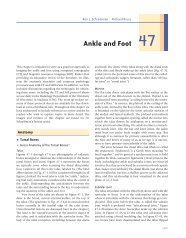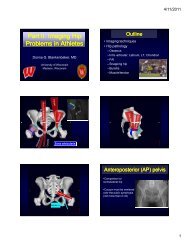CT Protocols: (Brain, ENT, Spine, Vascular) - Department of Radiology
CT Protocols: (Brain, ENT, Spine, Vascular) - Department of Radiology
CT Protocols: (Brain, ENT, Spine, Vascular) - Department of Radiology
Create successful ePaper yourself
Turn your PDF publications into a flip-book with our unique Google optimized e-Paper software.
70 Revised 7/22/09 (Gentry/Ranallo)<br />
Temporal Bone: (<strong>Vascular</strong> Mass): (Protocol – Adult: # 2.11 – Pediatric: #12.20 & 12.21)<br />
Billing:<br />
Setup:<br />
DFOV:<br />
1. <strong>CT</strong> Temporal Bone (without and with)<br />
2. Contrast<br />
1. Patient Supine, AP and lateral scouts, no gantry angle<br />
2. Extend the scouts to include aortic arch for smart prep.<br />
3. Only use 16 and 64 slice scanners<br />
4. Patient Positioning: Tilt the patient’s head so that a line connecting the lateral canthus <strong>of</strong><br />
the eye and the EAC is perpendicular to the <strong>CT</strong> tabletop (see head <strong>CT</strong> protocol).<br />
5. The dynamic portion is a monitored exam by an <strong>ENT</strong> radiologist or <strong>ENT</strong> Fellow.<br />
1. Posterior Fossa: Preferred 20 cm (Range 18-22 cm)<br />
2 TB: 9.6 cm<br />
Exam: Part 1: Temporal Bone <strong>CT</strong> Without Contrast<br />
1. Use the same protocol as described in the Temporal Bone W/O Contrast protocol<br />
2. This includes axial Recon 1, 2 and 3; the additional Retro recons <strong>of</strong> s<strong>of</strong>t tissue and <strong>of</strong><br />
bone; and all the reformatted 1 x 1 cm images <strong>of</strong> the temporal bones.<br />
Part 2: Dynamic Contrast Enhanced Exam Through the <strong>Vascular</strong> Mass (as described below)<br />
1. Select eight 2.5 mm scans through the vascular mass <strong>of</strong> posterior fossa (per radiologist)<br />
2. 1 image per sec X 5 (Using Cine Mode), then 1 image every 3 sec. X 3, then 1 image<br />
every 10 seconds X 2 (5 groups using Axial Mode with a Prep Group Delay <strong>of</strong> 2 sec and<br />
9 sec respectively) (scan time = 34 sec).<br />
3. Use 100 kV; 300 mA for adults, 150 mA for peds less than 6 y/o.<br />
4. Standard algorithm only<br />
5. Inject Contrast: Adults: Inject 150 ml <strong>of</strong> 240mg/ml at 4.0 ml per sec (Injection time = 37.5<br />
sec). Pediatrics: Inject 1 ml/lb (2 ml/kg) <strong>of</strong> 240 mg/ml contrast at 2 ml per sec<br />
6. Smart prep over superior vena cava; begin scanning with arrival <strong>of</strong> contrast in the<br />
superior vena cava<br />
7. As soon as all contrast has been injected immediately start Part 3<br />
Part 3: Temporal Bone Examination With Contrast<br />
1. Inject contrast and then obtain standard algorithm 1.25 mm scans with a 0.75 mm<br />
interval from the bottom <strong>of</strong> C1 to 1 cm above the top <strong>of</strong> temporal bone.<br />
2. Reconstruct the 1.25 mm axial slices into 2 mm x 2 mm images <strong>of</strong> the posterior fossa<br />
(axial, coronal, and sagittal) using an 18-22 cm DFOV with standard algorithm only.<br />
Patient Age: Choose the <strong>CT</strong> scan factors on the scanner for the proper age range <strong>of</strong> the patient<br />
2D Reformats:<br />
1. Child: (3 – 6 years)<br />
2. Infant: (0 – 3 years)<br />
1. Part 1: Do 1 mm by 1 mm 2D-reformations in the coronal, Stenver’s, and Pöschl planes<br />
2. Part 3: Do 2 mm by 2 mm 2D-reformations in the axial, coronal, and sagittal planes
















